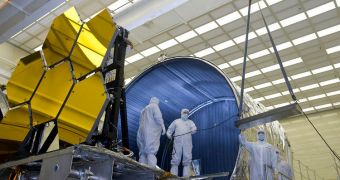NASA engineers have successfully completed a complex series of cryogenic tests on the main mirror of the James Webb Space Telescope (JWST). Divided into three segments with 6 mirrors each, the instrument was tested inside a protective, helium-cooled shroud.
This is the structure visible in the image to the left, behind the JWST mirror segment. By using it, engineers were able to replicate the harsh conditions of outer space, primarily the extreme cold that the mirrors will have to face.
Unlike the Hubble Space Telescope, which has a glass mirror, the JWST will feature 18 hexagonal beryllium mirrors, which will be joined together to create its main eye. The telescope has four sets of mirrors in total.
The cryogenic tests were carried out at the X-ray & Cryogenic Facility (XRCF), which is located at the NASA Marshall Space Flight Center (MSFC), in Huntsville, Alabama. The mirrors were subjected to temperatures as low as -414 degrees Fahrenheit (-248ºC).
In this image, the tube-like shroud is clearly visible. One of the JWST mirror segments sits on the base of the shroud, moments before being placed inside. The swing-like bar to the right is the counterweight for the crane used to move the six mirrors.
“The large tube is the back of the helium shroud that will go around the mirrors and cool them,” expert Lee Feinberg said. He is the NASA JWST Optical Telescope Element Manager at the GSFC.
“The gaseous helium shroud sits inside of a liquid nitrogen shroud […] which sits inside of a vacuum chamber. All three work together to create a vacuum and cold environment to test the mirrors,” the official went on to say.
One of the main reasons why the cryogenic tests were conducted was for engineers to assess the behavior of the mirrors' surfaces. Since these instruments are polished to atomic-scale precision levels, experts wanted to ensure that their shapes would not change when exposed to low temperatures.
A special sensor at the cryogenics facility was able to measure with extreme precision the deformations the mirrors underwent when temperatures dropped. Investigators determined that all devices performed within expected parameters.
JWST is the most complex space telescope ever designed, and requires the manufacturing of some extremely advanced components. Its 18-segment mirror is six times larger than Hubble's, and will enable it to peer back to a time when the first stars appeared.
The observatory is scheduled to launch in 2018.

 14 DAY TRIAL //
14 DAY TRIAL //